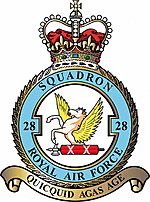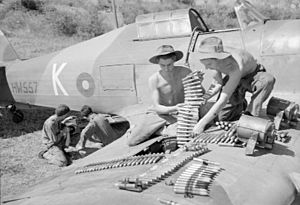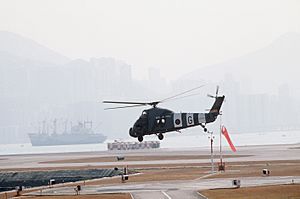No. 28 Squadron RAF facts for kids
Quick facts for kids No. 28 (AC) Squadron RAF |
|
|---|---|

Squadron badge
|
|
| Active | 7 November 1915 – 1 April 1918 (RFC) 1 April 1918 – 20 January 1920 (RAF) 1 April 1920 – 2 January 1967 1 March 1968 – 3 June 1997 17 July 2001 – present |
| Country | |
| Branch | |
| Type | Operational Conversion Unit |
| Role | Support helicopter training |
| Part of | Joint Helicopter Command |
| Home station | RAF Benson |
| Motto(s) | Quicquid agas age (Latin for 'Whatsoever you may do, do') |
| Aircraft | Boeing Chinook HC6A Westland Puma HC2 |
| Battle honours |
|
| Insignia | |
| Squadron badge heraldry | In front of a demi-Pegasus, a fasces. The demi-Pegasus represents the white horse on the downs near Yatesbury, the squadron's first operational base, while the fasces commemorates service in Italy during the First World War. Approved by King Edward VIII in October 1936. |
| Post-1950 squadron roundel | |
Number 28 Squadron, also known as No. 28 (Army Co-operation) Squadron, is a special group of aircraft and pilots in the Royal Air Force (RAF). It is based at RAF Benson in the UK. Today, its main job is to train pilots and crew to fly large helicopters like the Westland Puma HC2 and Boeing Chinook HC5/6/6A. This means it's an "Operational Conversion Unit," helping people learn to use these important aircraft.
Contents
History of No. 28 Squadron
Early Days: First World War
No. 28 Squadron started on 7 November 1915 as part of the Royal Flying Corps. At first, it was a training squadron, teaching pilots to fly different types of planes. It also helped defend the UK for a short time.
In July 1917, the squadron changed its role to become a fighter unit. It started flying the famous Sopwith Camel aircraft. These planes were used for air battles.
The squadron moved to France on 8 October 1917. Its first mission was during the Battle of Passchendaele. They helped protect other planes attacking a German airfield. Soon after, they were sent to Italy to help against an attack by Austro-German forces. In Italy, they flew missions to protect ground troops, scout enemy areas, and bomb targets.
On 1 April 1918, the squadron became part of the new Royal Air Force. They continued to fight in Italy, especially during the Second Battle of the Piave River and the Battle of Vittorio Veneto. They attacked enemy forces and helped stop their advances. By the end of the war, the squadron had shot down many enemy aircraft. They had several very skilled pilots, known as "flying aces," including William George Barker.
Between the World Wars
After the First World War, the squadron returned to Britain and was briefly disbanded. However, it was reformed on 1 April 1920 in India. Here, it became an "army cooperation" squadron, meaning it worked closely with ground troops. They flew Bristol F2b Fighter planes.
The squadron operated over the North-West Frontier Province, a challenging area. They moved between different bases like Kohat, Peshawar, and Quetta. Their planes helped with scouting and supporting ground forces. In 1935, they even flew relief flights to Quetta after a big earthquake. Later, they updated their aircraft to Westland Wapitis and then Hawker Audax planes.
Second World War Operations
When the Second World War began, No. 28 Squadron was still in India. In 1941, they started flying the Westland Lysander aircraft. In early 1942, they were sent to Burma to help fight against the Japanese invasion. They used their Lysanders to bomb Japanese airfields, railways, and troops. However, they faced heavy losses and had to pull back to India.
In March 1942, the squadron moved to Lahore to get new aircraft and pilots. They later moved to Ranchi. In December 1942, they received Hawker Hurricane IIb planes. These were used for both fighting and reconnaissance (scouting).
By January 1943, the squadron was back in action over Burma. They flew many missions, including scouting enemy positions and attacking Japanese boats. They were very busy, flying over 100 missions each month, even during the rainy monsoon season. In 1944, they started using Hurricane IIc planes, which had cannons. They also helped deliver mail to troops during the important Battle of Imphal and Battle of Kohima. Towards the end of the war, they began to receive Supermarine Spitfire planes.
After the Wars: 1946–1967
After the Second World War, the squadron continued to be a fighter-reconnaissance unit in the Far East. They replaced their Hurricanes with Supermarine Spitfires in 1945. They moved to different locations, including Penang, Kuala Lumpur, and Singapore.
In 1949, they moved to Hong Kong to help defend the area during the Chinese Civil War. Their role changed from scouting to mainly fighting. In 1951, they switched from propeller planes to jet aircraft, receiving de Havilland Vampire FB.5s. No. 28 Squadron was the last front-line RAF squadron to use the Spitfire. They later upgraded to Vampire FB.9s and then de Havilland Venoms. In 1962, they started flying Hawker Hunter FGA.9s until the squadron was disbanded on 2 January 1967.
Helicopter Era: 1968–Present
The squadron was reformed on 1 March 1968 in Hong Kong, this time flying helicopters. They started with Westland Whirlwind HC 10s and later introduced the Westland Wessex HC.2 in 1972. They stayed in Hong Kong until 1997, when the British handed over control of the territory. The squadron was disbanded on 3 June 1997, being the last RAF squadron to leave Hong Kong.
However, No. 28 Squadron was reformed again on 17 July 2001 at RAF Benson in the UK. This was the first time in a long while that the squadron was based in Britain. They started flying the Westland Merlin HC3 helicopters.
Their first mission with the Merlin helicopters was in Bosnia and Herzegovina in 2003. Later, in 2005, they deployed to Iraq to support Operation Telic. In 2009, they returned from Iraq and then deployed to Afghanistan for Operation Herrick. They returned from Afghanistan in May 2013.
In July 2015, the squadron changed its role. They passed their Merlin helicopters to another squadron and became an "Operational Conversion Unit." This means their new job is to train crews for the Chinook Mk4 and Puma Mk2 helicopters.
On 1 February 2018, the squadron officially became "No. 28 Squadron" again, dropping the "(Reserve)" part of its name. In March 2020, they were given a special honour for their role in the War in Afghanistan between 2001 and 2014. On 28 October 2021, they got their historical name back: No. 28 (Army Co-operation) Squadron.
See also
- List of Royal Air Force aircraft squadrons



